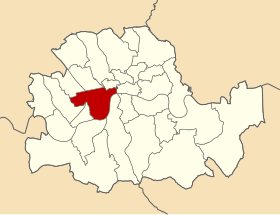City of Westminster (parish)
| Westminster | |
|---|---|
 Westminster within the County of London |
|
| Area | |
| • 1911 | 2,503 acres (10.13 km2) |
| • 1961 | 2,505 acres (10.14 km2) |
| Population | |
| • 1911 | 160,261 |
| • 1961 | 85,735 |
| Density | |
| • 1911 | 64/acre |
| • 1961 | 34/acre |
| History | |
| • Origin | Liberty of Westminster |
| • Created | 1900 |
| • Abolished | 1965 |
| • Succeeded by | London Borough of Westminster |
| Status |
Metropolitan borough City (1900–1965) Civil parish (1922–1965) |
| Government | Westminster City Council |
| • HQ | Westminster City Hall, St Martin's Place WC2 |
| • Motto | Custodi Civitatem Domine (O Lord, watch over the City) |
 Coat of arms of Westminster City Council |
|
The Metropolitan Borough of Westminster was a metropolitan borough in the County of London, England, from 1900 to 1965.
By royal charter dated 29 October 1900 the borough was granted the title City of Westminster. Westminster had originally been created a city and seat of the short-lived Diocese of Westminster in 1541. The diocese was suppressed in 1550, but the area was still known as a "city", although without official sanction.
The arms of Westminster represent two monarchs, closely associated with the City. Edward the Confessor, who rebuilt the church of St Peter (Westminster Abbey), and Henry VII, who added a chapel, within the Abbey. The portcullis and rose emblems are derived from the Tudor dynasty – from whom Westminster first achieved its status; and they appear throughout many public and religious buildings in Westminster, and the portcullis was adopted by the House of Commons. The supporting lions are adopted from the Cecil family, who have had a long association with the borough. The arms were first granted in 1601.
The motto Custodi Civitatem Domine, is translated as O Lord, watch over the City.
The arms can still be seen on the Portland stone parapet of the former Westminster City Hall in St Martin's Place (built in 1890–91 by Robert Walker, replacing an earlier vestry hall). It can also be seen on the entrance to the car park beneath 10 Spring Gardens, home of the British Council, Chelsea and Hammersmith Bridges.
It consisted of the area that is now part of the City of Westminster and south of Oxford Street and Bayswater Road. It included Soho, Mayfair, St. James's, The Strand, Westminster, Pimlico, Belgravia, and Hyde Park.
...
Wikipedia
